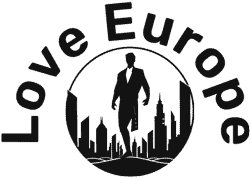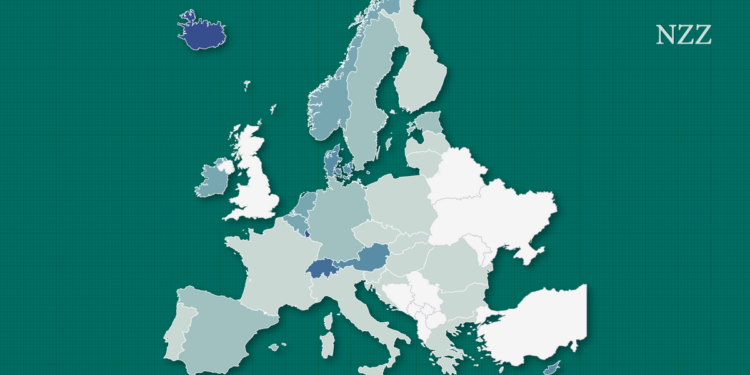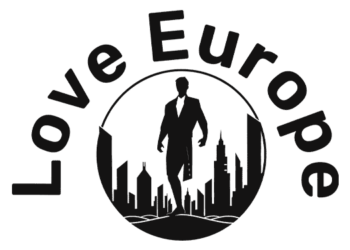The free movement of people between the EU and Switzerland is a politically charged issue. Some Swiss believe that too many Europeans are settling in the country. A range of factors make Switzerland an attractive destination.
Optimieren Sie Ihre Browsereinstellungen
NZZ.ch benötigt JavaScript für wichtige Funktionen. Ihr Browser oder Adblocker verhindert dies momentan.
Bitte passen Sie die Einstellungen an.
The European Commission sees the free movement of people as a major achievement. People should be able to move to where they find the best living and working conditions. From the EU’s point of view, this not only promotes individual happiness, but also adds cohesion to the union of states.
The Commission therefore vehemently defends the free movement of people – even for Switzerland, where some view it critically.
Surprisingly, Switzerland, of all countries, is one of the strongest magnets for EU citizens in Europe. In 2022, only Luxembourg and Malta had a higher share of EU citizens relative to their population. Expanding the scope to include the EFTA states, Iceland and Liechtenstein also outpaced Switzerland in relative terms.
However, Luxembourg, Malta and Iceland each have only a population of a few hundred thousand, Liechtenstein a few tens of thousands. That is why it is only of limited use to compare them with Switzerland. However, Switzerland and Luxembourg do have at least a few things in common: Both countries have a business-friendly tax system and an internationally oriented service sector. Both factors are driving forces behind immigration.
There are also other theories as to why Switzerland and Luxembourg attract so many EU citizens.
Highly educated migrants gravitate toward economically dynamic cities Over the past 30 years, migration in Europe has largely flowed from southeastern to northwestern Europe and into major metropolitan areas. The strongest pull, according to the Brussels-based think tank Espon, is the services sector. This applies to major Swiss cities.Espon also sees another pull effect: «Highly educated migrants tend to concentrate in the regions where the highly educated local populations concentrate,» they write. This also pattern holds for Switzerland’ major cities.Switzerland sits within the so-called blue banana, the economic backbone of Europe. This arc stretches from London to the Benelux region, the Rhineland and northern Italy – and resembles a banana. Educational institutions, research facilities, infrastructure and globally active companies are concentrated here. The demand for skilled workers is correspondingly high.High-quality public services, a pleasant social climate and a reliable administration also attract immigrants.In Switzerland, the three major European languages are German, French and Italian. Over 220 million people live in countries where these languages are also spoken. This lowers the barrier to migration to Switzerland.
This may help explain why French-speaking Switzerland, Ticino and Zurich are among the regions in Europe with the highest percentage of EU citizens. Only in Luxembourg is it even higher. These areas are not only urban hubs but also centers of economic diversity.
EU citizens make up nearly 53% of all immigrants to Switzerland, a figure unmatched by any other major European country. By contrast, Eastern European countries attract far fewer European migrants, which could prove to be an economic liability. A lack of highly skilled migrants from Western Europe may limit their long-term growth prospects.
Also a magnet for commuters
The dynamics of the Swiss economy and the role of geography are also reflected in commuter movements. Only Germany, with its extensive borders, has more cross-border commuters than Switzerland. Luxembourg is also a magnet, with similarities to Switzerland in its internationally oriented service sector and its location. Luxembourg attracts large numbers of cross-border commuters from Germany, France and Belgium.
The EU is concerned about emigration
While many EU countries still have relatively small populations of citizens from other member states, internal migration has increased in recent years. However, politicians and economists often view these trends in different ways.
Former ECB President Mario Draghi, for example, laments in his report on EU competitiveness that relatively few Europeans continue to move to another EU country. Internal migration is far more common in the U.S. He attributes the disparity to language and cultural barriers, but also to the lack of mutual recognition of professional and academic qualifications.
At the same time, some voices within the EU take a more critical view of some aspects of free movement. In spring 2024, former Italian Prime Minister Enrico Letta outlined several pressing concerns in a report for the European Council. The first problem, he said, is the trend of internal EU migration toward booming cities, where some locals increasingly complain about housing shortages.
But an even more serious consequence, he says, is the population decline across many parts of the EU. An estimated 135 million EU citizens, almost a third, live in areas that have fallen behind demographically over the past 20 years Letta notes. The working-age population in these areas is shrinking, and there is a shortage of skilled workers.
More deaths than births
Since 2012, deaths have outnumbered births in the EU. The bloc’s population continues to grow, but only as a result of immigration. However, this trend is not uniform across all member states. In recent years, seven countries – Bulgaria, Greece, Italy, Latvia, Hungary, Poland and Slovakia – have seen their populations decline.
Latest articles
Global reporting. Swiss-quality journalism.
In today’s increasingly polarized media market, the Switzerland-based NZZ offers a critical and fact-based outside view. We are not in the breaking-news business. We offer thoughtful, well-researched stories and analyses that go behind the headlines to explain relevant events in the U.S., in Europe and worldwide. To produce this work, the NZZ maintains an industry-leading network of expert reporters around the globe who work closely with our main newsroom in Zurich.
Sign up for our free newsletter or follow us on Twitter, Facebook or WhatsApp.
Source link : http://www.bing.com/news/apiclick.aspx?ref=FexRss&aid=&tid=679ea9e21ab4432d8ffad5f4adde4454&url=https%3A%2F%2Fwww.nzz.ch%2Fenglish%2Fwhy-so-many-europeans-move-to-switzerland-ld.1868159&c=2763513433976566372&mkt=en-us
Author :
Publish date : 2025-01-30 05:36:00
Copyright for syndicated content belongs to the linked Source.


